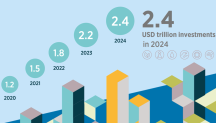

Intersolar Middle East Gathers Region’s Brightest in Solar
Newsletter
Since the end of 2009, the price of solar photovoltaics (PV) has fallen more than 80%, and the Middle East and North Africa region has been quick to seize upon the opportunities this price decline presents. An estimated 2,000 MW of solar energy projects in the region will be tendered in 2016, and by 2020, $50 billion will be invested in the region’s solar sector.
Solar investment and innovation is kicking off a regional transformation in energy production. From 19 to 21 September, Dubai International Exhibition Centre hosted Intersolar Middle East, a forum and exhibition for the solar industry and its partners to continue and accelerate this transformation.
“Intersolar Middle East is one of the biggest events for the solar energy in this region, and an opportunity for IRENA to help influence and guide development in the sector and to promote sustainable growth,” says Rabia Ferroukhi, Deputy Director of IRENA’s Knowledge, Policy and Finance Centre. She was one of the panel members that took part in the ‘MENA Leaders Round Table: Towards a renewable energy economy’ event held on Intersolar Middle East’s opening day.
“We can now put to rest the myth that renewables are expensive. Globally we’ve seen the price of renewables fall — in some places solar PV has dropped below 3 cents/kWh and wind below 4 cents/kWh. These price drops are not restricted to rich countries either, and auctions have shown that even in places one would not expect, renewables are becoming a lowest-cost option. Prices at the latest solar auctions in Zambia have been as low as 6 cents/kWh,” explains Ferroukhi.
The round table Ferroukhi took part in discussed, the effects of pricing on regional and global markets, sustainable benchmarks for solar tariffs and pricing, the effects of low oil prices on renewable energy markets, the main challenges facing the region in terms of infrastructure limitations, grid integration, investment and financing are, and how these can be overcome.
A platform to share IRENA’s work
IRENA took advantage of this global gathering of stakeholders to share its work and findings in the solar energy sector, including The Power to Change: Solar and Wind Cost Reduction Potential to 2025 which came out earlier this year, and Solar PV Costs and Markets in Africa which debuted at the event.
“Intersolar is a prominent place for us to release our solar PV in Africa report and share its findings with a knowledgeable, engaged audience that is active in the region and globally” says Michael Taylor, Senior Analyst at IRENA’s Innovation and Technology Centre. “We’ve found that the economic potential for solar PV in Africa’s sunbelt is finally beginning to be unlocked with the recent cost reductions in solar PV modules and components. The potential benefits for 600 million African’s who lack access to electricity are profound. Solar Home Systems can now typically provide better quality energy services like lighting and mobile phone charging, at the same or lower cost as polluting energy sources like kerosene,” Taylor says.
The report explains how mini-grids offer a large opportunity for the continent, but that cost ranges vary greatly depending on location, nature of the development, transport and logistics costs, level of electricity storage, and whether the project is a new mini-grid or a hybridisation of an already existing grid. At the utility-scale, the installed costs of solar PV costs have fallen by as much as 61% between 2012 and today.
Speaking at the ‘Solar power possibilities in the age of innovation’ panel discussion held on 20 September, IRENA’s Innovation and Technology Centre’s Senior Programme Officer, Takatsune Ito, shared his view on the next generation of technological advancements and innovations that will revolutionise the market in the coming years.
“Since the 1960s, solar technology, and particularly solar PV has seen rapid advancement,” explains Ito. “Where once the technology was seen as a future technology, today it is common place and could revolutionise the PV market in the coming years.” At the discussion Ito and others in the solar field shared their thoughts on efficiency in solar conversion, solar power storage products, solar sharing, portable solar power systems, solar desalination, solar transportation (aircraft and cars), solar roads, solar powered enhanced oil recovery, and solar powered 3D printing.
An Intersolar world
Though this Intersolar event was held in Dubai, Intersolar operates around the world and hosts similar events for different regions. In June, IRENA took part in Intersolar Europe, held in Munich, Germany. In August, São Paulo, Brazil, hosted Intersolar South America. The next Intersolar event will be Intersolar India, to be held in Mumbai from 19 to 21 October 2016.




